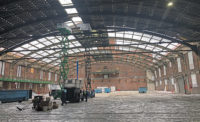Working as a laborer in his youth alongside his cousins was one of William J. Gilbane Jr.’s most valuable experiences at his family’s construction company. One summer, they built reinforced concrete dormitories at the University of Rhode Island, stripping forms and handing them up to carpenters on the floor above for hours without seeing sunlight.
“After jackhammering most of the day, my hands were so sore I couldn’t hold an ear of corn over dinner,” Gilbane recalls. “My mother would strip the corn off the cob for me.”
Gilbane, 70, went on to help Providence-based Gilbane Building Co. establish five additional offices in New England. While leading the New England region from 1983-2001, the firm grew to have $800 million in annual revenue and a staff of 400.
“Those who know Bill describe him as a visionary, a leader who gets people excited,’” said Mark Hasso, a professor of construction management at Wentworth Institute of Technology while introducing him at ENR New England’s December awards event in Boston.
Gilbane, the firm’s current vice chairman and former president and chief operating officer, enjoys mentoring family in the business. But he is also known for developing Gilbane’s workforce.
In 2007, ENR honored him as one of its Top 25 Newsmakers for creating an in-house immersive training program, viewed as one of the most effective in the construction industry at the time.
Among his awards and honors are the 2015 Champion Award from the Women Builders Council and the 2014 March of Dimes Service to Humanity Award. He is a four-time Construction Users Roundtable safety excellence award winner. And the former Brown University hockey player served as a member of the U.S. Olympic Committee.
Gilbane says one of his most memorable events was the 2017 dedication of the Nancy and Bill Gilbane Community Center by ReFocus, a nonprofit serving adults with physical and developmental needs.
Gilbane has also “given back to the industry with his strong support of the [Architecture Construction Engineer] Mentor Program,” says Bruce D’Agostino, former Construction Management Association of America president and chief executive.
Calling Gilbane “an innovator and collaborator,” D’Agostino says Gilbane’s “early use of integrated project delivery” created successful school construction programs and “built a stellar reputation for Gilbane Building Co.”
Fourth-Generation Leader
Gilbane Building Co. was founded 145 years ago as a carpentry business by William Gilbane, the Legacy Award winner’s great grandfather. Currently, the business, both a construction manager and a general contractor, has 2,738 employees, $4.89 billion in annual revenue and 80 shareholders.
Gilbane Jr. grew up on construction. “After Mass on Sunday, we’d pile into [my father’s] Oldsmobile with my five sisters,” he recalls. “My father would grab me by the hand and show me what was going on. I loved it.”
After graduating from Brown in 1970, Gilbane joined BT Equipment Corp., a subsidiary of Gilbane. There, he managed construction equipment leasing and rentals and rose to president.
When he joined Gilbane in 1980 as a project manager and project executive, he continued to manage BT. He held that post until Gilbane sold BT in 1996.
Like his father, Gilbane made time to take his own five children—four of whom currently work at the firm—on project tours while they were young. William Gilbane III, a senior vice president in the New York division, says his father taught him the “importance of relationships and staying true to our values.”
Learning to Lead
The year Gilbane joined the family’s construction company, in 1980 at age 32, his uncle, Thomas F. Gilbane, then a vice president, died. At the time, his father was almost legally blind—though he was still influential as chairman, says the son.
By 1983, the company was in need of new leadership. In the transition, Gilbane Jr. became the New England regional manager. In taking the reins as an executive, Gilbane Jr., accustomed to his role as an employee, worried about his promotion, which meant “suddenly” managing people he worked for and alongside.
His new responsibilities also included creating new business to grow the firm. “I questioned whether I was the right person for this tough assignment,” Gilbane says.
His doubts were squelched by the realization that the staff wasn’t “going to let us fail,” he says. He was also buoyed by the culture of success that had been created by his uncle and father.
In his new management position, Gilbane relied heavily on consensus. He recalls when John McCoy, then the operations manager, pulled him aside to say, “‘We appreciate that you listen to us, but we want you to be a benevolent dictator and make decisions.’”
Gilbane says such “candor and respect is a benefit of working in a family-run business.”
Emboldened by the advice, Gilbane went on to expand the company gradually. When he took over, Gilbane had seven offices. Currently, there are 46.
His initial push in New England was done with limited resources. Then, the company’s “major growth spurt” diverted a “focus” from the local market. Nevertheless, Gilbane not only maintained the bottom line in Rhode Island, but he says that by 1988 he had also established a presence in New Hampshire and Connecticut, with projects such as the Manchester Civic Center and the Connecticut Convention Center in Hartford.
Gilbane continued to grow the firm after he was promoted to executive vice president in 2001 and president and chief operating officer in 2004. During the recession in the late 2000s, Gilbane and his cousin Tom Gilbane, the current chairman, decided to expand the disciplines offered by purchasing Innovative Technical Solutions, a design-build infrastructure and environmental firm based in Walnut Creek, Calif.
The wholly owned subsidiary added “an international dimension” that increased overall revenue by more than $300 million annually and allowed Gilbane to expand both nationally and globally, including into Mexico, Saudi Arabia and Japan.
The move helped increase work from the Dept. of Defense, including the Army Corps of Engineers. It also led to other non-U.S. projects, such as the 282,000-sq-ft Kerry Global Technology and Innovation Center in County Kildare, Ireland, completed three years ago.
People Person
Tom Gilbane describes his cousin as “a people person who developed a customer advocacy approach” to business. He says Bill was an early supporter of client satisfaction surveys.
Typically, Gilbane receives 1,000 individual surveys a year. The feedback is used to identify areas for improvement and form the basis of individual performance reviews.
To achieve customer satisfaction, Gilbane Jr. instituted an in-house training platform, named Gilbane University. By watching his father successfully manage people, he learned quality control and client advocacy. He learned practices such as zero defects, executive integrity and embracing change at the Philip Crosby Quality College in 1986. Incorporating academic ideas into the firm’s culture required defining the requirements for “quality” as “client satisfaction,” he says, adding, “We changed the vernacular, so our people would accept it as ‘Gilbane’—not some textbook.”
In 2017, Gilbane Building spent $6 million on staff training and development, an average of $2,000 per employee, “which is well above U.S. corporate standards,” the firm says. It offers hundreds of online and in-person courses on technical, management and leadership skills. Employees are required to receive 30 hours of training annually.
Gilbane is a 13-time member of Training Magazine’s Top 125 for designing and implementing employee programs that yield demonstrable business outcomes. Gilbane III says his father “has proven that you can be a successful leader while also emphasizing people.”
Succession
Working from his home office in Jupiter, Fla., Gilbane Jr. still is a principal on major projects. He also works on diversity, Lean Construction and safety initiatives. Though he still works full time, Gilbane no longer manages financial budgets or strategic business plans. In his spare time, he plays golf with sports legends such as former Boston Bruins defenseman Bobby Orr. “I’m really a lucky guy,” he says.
Gilbane plans to keep on working. “When you work in a family-run business,” he says, “it becomes a part of who you are.”
Still, succession is always on his mind, especially when he goes through company memorabilia in his garage and shares his finds with clients and relatives—including the firm’s four fourth-, 14 fifth- and one sixth-generation “Gilbaners.”
He predicts a contingent of 25 fifth- and sixth-generation relatives will be working at the company in the next 10 years. “I’m confident Gilbane will be better in the next generation,” he says. “They’re better trained than us.”









Post a comment to this article
Report Abusive Comment